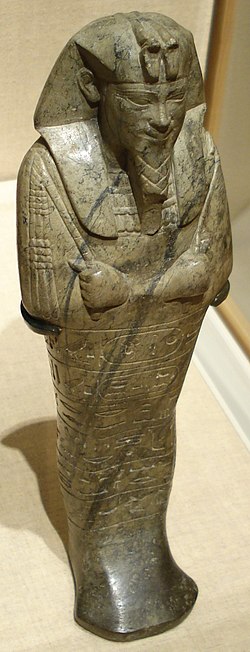Senkamanisken
| Namen von Senkamanisken | ||||||||||
|---|---|---|---|---|---|---|---|---|---|---|
| Thronname | in ägyptischen Hieroglyphen | |||||||||
| Eigenname | in ägyptischen Hieroglyphen | |||||||||
Senkamanisken war ein nubischer König, der um 620 v. Chr. regierte. Er war mit Amanimalel und Nasalsa verheiratet und hatte die Söhne Anlamani und Aspelta, die seine Nachfolge antraten.
Belege

Er ist vor allem von seiner Pyramide Nu 3 bei Nuri bekannt. Beim Berg Barkal fanden sich Statuen von ihm, die hier anscheinend während eines ägyptischen Angriffes versteckt oder begraben worden sind. Von dort stammt auch eine Sphinx mit seinem Namen.[1] Objekte mit Namen des Herrschers fanden sich auch in Meroe[2], das also damals schon eine gewisse Bedeutung hatte. Ein Fragment einer Opfertafel mit seinem Namen stammt aus Memphis in Ägypten.[3]
Weitere Namen
- Horusname: Sehertaui
- Nebti-Name: Dihermaat (?)
- Goldname: Weserpehti
- Thronname: Secheperenre
- Eigenname: Senkamanisken
Monumente des Senkamanisken
- Senkamanisken, Kerma Museum
- Senkamanisken, Kerma Museum
- Senkamanisken, Senkamanisken, Kerma Museum
- Statue des Senkamanisken, Boston Museum of Fine Arts
- Königin Amanimalil, vielleicht Gemahlin von Senkamanisken
- Uschebti des Senkamanisken
- Pyramide des Senkamanisken (rechts)
Siehe auch
Literatur
- Dows Dunham: The Royal Cemeteries of Kush. Band II: Nuri. Museum of Fine Arts, Boston 1955, OCLC 493656354, S. 41–47, 256; abrufbar über Section Française de la Direction des Antiquités du Soudan (SFDAS).
- Dows Dunham, M. F. Laming Macadam: Names and Relationships of the Royal Family of Napata. (= The Journal of Egyptian Archaeology. (JEA) Band 35). Egypt Exploration Society (EES), London Dezember 1949, S. 139–149; abrufbar über JSTOR.org.
- Bertha Porter, Rosalind L. B. Moss, Ethel W. Burney: Topographical Bibliography of Ancient Egyptian Hieroglyphic Texts, Reliefs, and Paintings. Band VII: Nubia, The Deserts, and outside Egypt. Griffith Institute / Ashmolean Museum, Oxford 1975, S. 225 (Volltext als PDF; 21,6 MB); abgerufen über The Digital Topographical Bibliography.
Anmerkungen
- ↑ Derek A. Welsby, Julie R. Anderson (Hrsg.): Sudan, Ancient Treasurers. An exhibition of recent discoveries. British Museum Press, London 2004, ISBN 0-714119-60-1, S. 161, Nr. 144.
- ↑ László Török, Inge Hofmann, István Nagy: Meroe City, an Ancient African Capital. John Garstang's excavations in the Sudan (= Occasional publications // Egypt Exploration Society. Nr. 12). Egypt Exploration Society, London 1997, ISBN 0-85698-137-0, S. 235–241.
- ↑ Jeremy Pope: Napatan Period. In: Wolfram Grajetzki, Willeke Wendrich (eds.): UCLA Encyclopedia of Egyptology. Los Angeles 2020, ISSN 2693-7425, S. 2 online.
Weblinks
| Vorgänger | Amt | Nachfolger |
|---|---|---|
| Atlanersa | König von Nubien ca. 620 v. Chr. | Anlamani |
| Personendaten | |
|---|---|
| NAME | Senkamanisken |
| KURZBESCHREIBUNG | König von Nubien |
| GEBURTSDATUM | 7. Jahrhundert v. Chr. |
| STERBEDATUM | 7. Jahrhundert v. Chr. |
Auf dieser Seite verwendete Medien
Autor/Urheber: tobeytravels, Lizenz: CC BY-SA 2.0
During the excavation of a temple in Dukki Gel in January 2003,a pit containing 40 black granite statue fragments was discovered.It was identified as a favissa, where venerated sculptures were deposited for safety, handled with great care. The statues were deliberately broken in order to destroy the “power” of the pharaohs represented: all are broken at the neck and the legs, and occasionally so are the arms, the mekes cases, the nose or the uraei.
The granite is carefully polished, but some details of the clothing, the adornment or the skullcap are roughened. With this treatment, pigments and fabric covered with a thin layer of gilded gesso could better adhere to the stone.
The so called Black Pharaohs are Taharqa, Tanwetamani, Senkamanisken, Anlamani, and Aspelta, who ruled Egypt in the 25th Dynasty.Autor/Urheber: Matthias Gehricke, Lizenz: CC BY-SA 4.0
Senkamanisken statue, Kerma Museum
Autor/Urheber: Matthias Gehricke, Lizenz: CC BY-SA 4.0
Statue der Königin AMANIMALILEines der großen künstlerischen Meisterwerke des Königreichs Napata. Die Königin wird auf der Hintersäule als "Geliebte des Amun von Napata, der in dem heiligen Berg wohnt" bezeichnet. Gefunden 1916 von George Reisner in einem Versteck in B 500 am Jebel Barkal.
Autor/Urheber: tobeytravels, Lizenz: CC BY-SA 2.0
Tantamani, Black Pharaohs Cache (Dukki Gel), Kerma Museum, Sudan
During the excavation of a temple in Dukki Gel in January 2003, a pit containing 40 black granite statue fragments was discovered. It was identified as a favissa, where venerated sculptures were deposited for safety, handled with great care. The statues were deliberately broken in order to destroy the “power” of the pharaohs represented: all are broken at the neck and the legs, and occasionally so are the arms, the mekes cases, the nose or the uraei. The granite is carefully polished, but some details of the clothing, the adornment or the skullcap are roughened. With this treatment, pigments and fabric covered with a thin layer of gilded gesso could better adhere to the stone.
The so called Black Pharaohs are Taharqa, Tanwetamani, Senkamanisken, Anlamani, and Aspelta, who ruled Egypt in the 25th Dynasty.Autor/Urheber: Jac Strijbos8, Lizenz: CC BY-SA 3.0
Senkamanisken, wearing the skin of the feline over his torso
Autor/Urheber: One dead president, Lizenz: CC BY-SA 3.0
Funerary figurine of Kushite king Senkamanisken. Steatite. Napatan kingdom, reign of Senkamanisken, c. 643-623 BC. From the Nuri necropolis in Napata.
Autor/Urheber: Bruce Allardice, Lizenz: CC BY-SA 2.0
Nuri Pyramid Nu #I: King Taharqa r. 690-664 BCE XXV Dyn Nuri Pyramid Nu #III: Senkamanisken r. c. 643-c.623 BCE
Autor/Urheber: Marcus Cyron, Lizenz: CC BY 3.0
Statue of King Senkamanisken Boston Museum












